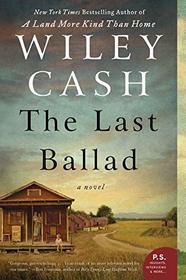This well-written but ultimately depressing novel is based on true events from the battle to unionize North Carolina textile mill workers in 1929.
The book's main character, Ella May Wiggins, is a young woman with four children to feed and an absent husband. She goes to work in a major textile mill where cotton is processed and spun for weaving, working a 70-hour week for $9. She bangs heads with management when she misses a shift to care for one of her children, who is desperately ill with whooping cough â a disease which had earlier taken one of her babies. The young woman, whose life up to that point had consisted of desperate poverty, grinding labor, and deprivation, is attracted to the burgeoning labor movement, led in Gastonia by Communist party organizers from the North. At first only curious, she is swept into becoming a figurehead of the movement, and ultimately is at its center when a major strike erupts into violence.
Cash creates a number of characters for the book, some based on historical figures, some fictional. His sympathies are largely with Wiggins. He doesn't refrain from acknowledging that she was used by some of the organizers who saw a sympathetic figurehead just at the time they needed one to get the planned strikes off the ground. In addition, Wiggins lived and worked with African-Americans in one of the only integrated work forces in the region. It's this association and drive for integration of the union that ultimately drives a wedge into the striking laborers and provides the mill owners with a powerful weapon.
Written in 2017, there are eerie echoes (or foreshadowings) within the rhetoric of both sides. We heard many of these same terms bandied about during 2020's Black Lives Matter movement. It's unclear whether the facsimile newspaper pages in the book are Cash's creations or genuine reproductions, but the anger, the hysteria, the false accusations, and the genuine fear of loss expressed in them could have been printed in any American city nearly a century after the Gastonia riots. They are rife with accusations of âfake newsâ, âoutside agitatorsâ, exhortations to âproud Americans'' to âstand with us tomorrow and help us put down any insurrection that seeks to overthrow our government and alter our way of lifeâ. In all caps, yet.
Apparently, we haven't learned much.
Cash uses flashbacks, framing devices, and sifting points of view to unspool his story, so if you don't want to know on page 48 what happens to Ella on page 360, this may not be the book for you. He also depends heavily on coincidence with some characters weaving their way in and out of the story and appearing just in time for maximum emotional impact.
Minor quibbles aside, this novel throws light on historical events that have largely been ignored or forgotten, and is well worth a read. Just don't expect to come away from it with a happy heart.
The book's main character, Ella May Wiggins, is a young woman with four children to feed and an absent husband. She goes to work in a major textile mill where cotton is processed and spun for weaving, working a 70-hour week for $9. She bangs heads with management when she misses a shift to care for one of her children, who is desperately ill with whooping cough â a disease which had earlier taken one of her babies. The young woman, whose life up to that point had consisted of desperate poverty, grinding labor, and deprivation, is attracted to the burgeoning labor movement, led in Gastonia by Communist party organizers from the North. At first only curious, she is swept into becoming a figurehead of the movement, and ultimately is at its center when a major strike erupts into violence.
Cash creates a number of characters for the book, some based on historical figures, some fictional. His sympathies are largely with Wiggins. He doesn't refrain from acknowledging that she was used by some of the organizers who saw a sympathetic figurehead just at the time they needed one to get the planned strikes off the ground. In addition, Wiggins lived and worked with African-Americans in one of the only integrated work forces in the region. It's this association and drive for integration of the union that ultimately drives a wedge into the striking laborers and provides the mill owners with a powerful weapon.
Written in 2017, there are eerie echoes (or foreshadowings) within the rhetoric of both sides. We heard many of these same terms bandied about during 2020's Black Lives Matter movement. It's unclear whether the facsimile newspaper pages in the book are Cash's creations or genuine reproductions, but the anger, the hysteria, the false accusations, and the genuine fear of loss expressed in them could have been printed in any American city nearly a century after the Gastonia riots. They are rife with accusations of âfake newsâ, âoutside agitatorsâ, exhortations to âproud Americans'' to âstand with us tomorrow and help us put down any insurrection that seeks to overthrow our government and alter our way of lifeâ. In all caps, yet.
Apparently, we haven't learned much.
Cash uses flashbacks, framing devices, and sifting points of view to unspool his story, so if you don't want to know on page 48 what happens to Ella on page 360, this may not be the book for you. He also depends heavily on coincidence with some characters weaving their way in and out of the story and appearing just in time for maximum emotional impact.
Minor quibbles aside, this novel throws light on historical events that have largely been ignored or forgotten, and is well worth a read. Just don't expect to come away from it with a happy heart.
Excellent historical fiction about a strike at a paper mill in the 1820's when the union fought to let people of color in. Very poignant and moving.




